The Miami Marlins, formerly known as the Florida Marlins, have consistently sought to forge a distinct identity throughout their baseball history. In 2012, a significant rebranding marked a new chapter, transitioning from the “Florida” moniker to “Miami” and moving into the newly constructed Marlins Park. While the team’s name and home venue evolved, the essence of the Marlins, deeply rooted in South Florida baseball since 1956, remained. One of the most visible aspects of this identity, and a key element in connecting with fans, is the team’s uniforms. Uniforms serve as powerful visual symbols, capable of establishing a team’s image in the eyes of both local supporters and rivals. Some teams achieve iconic status through sustained success, like the New York Yankees, others through enduring tradition, such as the Chicago Cubs, and some, like the Houston Astros, are known for their frequent stylistic shifts. The Marlins, while not as drastically changing as the Astros, have presented a fascinating evolution of looks. Let’s journey back in time to explore the captivating visual history of the Fighting Fish and their diverse range of Florida Marlins Uniforms.
Our exploration begins with the original Miami Marlins of the International League. This team, established in 1956 after relocating from Syracuse, served as a AAA affiliate for both the Philadelphia Phillies and later the Baltimore Orioles. From 1956 to 1960, they played at Miami Stadium, with occasional games at the Orange Bowl, sporting team colors of Orange, Blue, and White. The home uniforms were a crisp white, featuring a cursive “Marlins” script emblazoned across the chest in blue. Blue piping added a touch of detail around the neck and down the front, parallel to the buttons. A blue stripe near the cuff of both sleeves and a unique Marlin logo on the left sleeve – depicting the fish carrying a bat and wearing a cap – further defined the look. The cap was blue with an orange block letter “M”, available in versions with either an orange or blue bill.
 Vintage Miami Marlins home uniform from 1956-1960, featuring a white base, blue cursive "Marlins" script, and a sleeve patch of a marlin with a bat.
Vintage Miami Marlins home uniform from 1956-1960, featuring a white base, blue cursive "Marlins" script, and a sleeve patch of a marlin with a bat.
The road uniforms were rendered in gray, displaying “MIAMI” in block letters. They mirrored the home uniform’s design, maintaining the blue piping and sleeve details, but with orange stripes on the sleeve cuffs instead of blue.
 Miami Marlins gray road uniform from 1956, showcasing "MIAMI" in block letters and orange sleeve stripes, representative of their International League era.
Miami Marlins gray road uniform from 1956, showcasing "MIAMI" in block letters and orange sleeve stripes, representative of their International League era.
This early iteration of the Miami Marlins even featured legendary pitcher Satchel Paige for a few seasons. Despite some initial popularity, the team’s success on the field was limited, and fan attendance eventually dwindled, leading to the franchise’s relocation to San Juan, Puerto Rico, in 1961.
However, Miami’s absence from minor league baseball was short-lived. In 1962, a new Miami Marlins franchise emerged with the reactivation of the Single A-Advanced Florida State League team, the Miami Hustlers. Remarkably, this new Marlins team retained almost everything from its predecessor: the name, colors, stadium, logos, and uniforms. This version of the Marlins found greater success, capturing the FSL Championship in both 1969 and 1970. They continued their affiliations with the Phillies and then the Orioles. In 1971, in a move to align more closely with their major league affiliate, the Marlins were renamed the Orioles. The Miami Marlins name remained dormant until 1982, when the Orioles ended their association with the Miami franchise.
The revived Miami Marlins of 1982 introduced subtle changes to their visual identity. While the team colors remained consistent, the home white uniforms adopted block lettering for the “MARLINS” script, mirroring the style of the road uniforms, which also switched from “MIAMI” to a “MARLINS” script. Notably, the blue piping around the neck and down the front of both jerseys was removed, as was the Marlin logo from the sleeves. The sleeve stripes were updated to an orange-blue-orange pattern at the cuffs. The caps remained unchanged, preserving a visual link to the earlier eras. This minor-league run of the Miami Marlins continued until 1989, when the team rebranded as the Miracle and relocated to Fort Myers in 1992, coinciding with the arrival of a new Major League Baseball franchise in Miami.
Unfortunately, visual records of the 1980s Marlins are scarce. Therefore, we must look to the 2002 Florida Marlins, who donned uniforms reminiscent of this era as part of a 20th-anniversary celebration of the previous Marlins incarnation, to get a sense of their look.
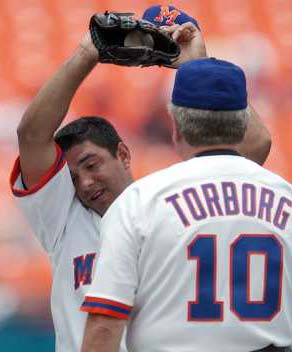 Florida Marlins players in 2002 wearing throwback uniforms inspired by the 1980s Miami Marlins minor league team, during a game against the Atlanta Braves.
Florida Marlins players in 2002 wearing throwback uniforms inspired by the 1980s Miami Marlins minor league team, during a game against the Atlanta Braves.
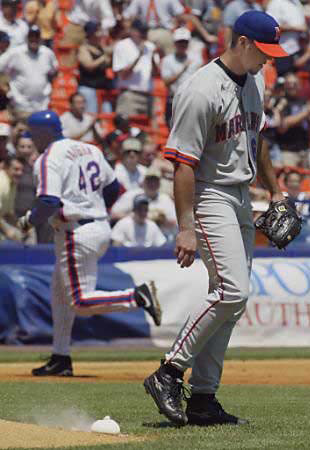 A closer view of the 2002 throwback Miami Marlins uniform, highlighting the block letter "MARLINS" script and orange-blue-orange sleeve stripes, worn in a game against the New York Mets.
A closer view of the 2002 throwback Miami Marlins uniform, highlighting the block letter "MARLINS" script and orange-blue-orange sleeve stripes, worn in a game against the New York Mets.
The year 1993 marked a monumental shift with the arrival of Major League Baseball in South Florida and the debut of the Florida Marlins. The “Florida” name was chosen to represent the entire state, as the Marlins were then Florida’s sole MLB franchise. A dramatic change in color palette accompanied this major league entry, moving towards teal, black, silver, white, and sparingly used orange. Miami Stadium was deemed inadequate for MLB standards in terms of capacity and modern amenities, especially compared to the relatively new Joe Robbie Stadium.
The inaugural home uniform of the Florida Marlins was white with teal pinstripes. The “MARLINS” script across the chest was rendered in teal with a black outline. The player number was black, positioned on the right side below the script. The left sleeve proudly displayed the Marlins logo. A sleeveless version of the home white uniform was also introduced, initially worn with a teal undershirt, later changed to black. The road uniform was gray, featuring “FLORIDA” in a distinct font, with a Marlin fish cleverly wrapped around the “F”. The Marlins logo adorned the left sleeve, and both sleeve cuffs featured black-teal-white stripes. The caps were available in teal, teal with a black bill, and all black, each featuring a silver and black block “F” logo intertwined with a Marlin.
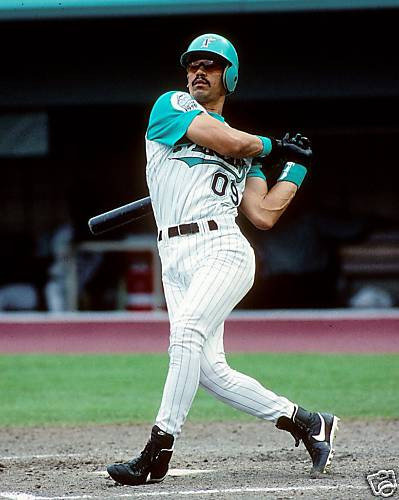 Florida Marlins player in the original 1993 home uniform, showcasing teal pinstripes and the teal "MARLINS" script with black outline.
Florida Marlins player in the original 1993 home uniform, showcasing teal pinstripes and the teal "MARLINS" script with black outline.
 A Florida Marlins cap from the 1993-2002 era, featuring a teal base with a black bill and the distinctive "F-Marlin" logo in silver and black.
A Florida Marlins cap from the 1993-2002 era, featuring a teal base with a black bill and the distinctive "F-Marlin" logo in silver and black.
 Florida Marlins pitcher Livan Hernandez in the gray road uniform, highlighting the "FLORIDA" script with the marlin wrapped around the 'F', worn during the early MLB years.
Florida Marlins pitcher Livan Hernandez in the gray road uniform, highlighting the "FLORIDA" script with the marlin wrapped around the 'F', worn during the early MLB years.
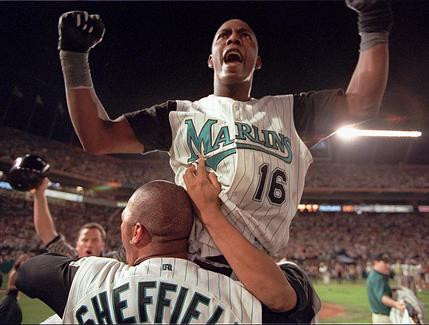 The iconic Florida Marlins teal cap, a signature element of their original color scheme, featuring the "F-Marlin" logo, worn during their initial MLB seasons.
The iconic Florida Marlins teal cap, a signature element of their original color scheme, featuring the "F-Marlin" logo, worn during their initial MLB seasons.
In this original uniform set, the Florida Marlins achieved remarkable success, winning the World Series in 1997. However, the team was subsequently dismantled and entered a period of struggles under various ownership groups. In 2002, Jeffrey Loria acquired the team, and the Marlins celebrated their tenth anniversary in 2003 with subtle uniform modifications. The home white uniforms switched to black pinstripes, replaced the Marlins sleeve logo with the “F” cap logo, and updated the script to black with teal and silver outlines. The road uniforms mirrored these changes, most notably adopting the “FLORIDA” script in the same font as the home script (which would later evolve to “Marlins”). The Marlins also introduced a new black alternate jersey, styled similarly to the updated home and road jerseys but featuring a silver “Marlins” script outlined in teal and black.
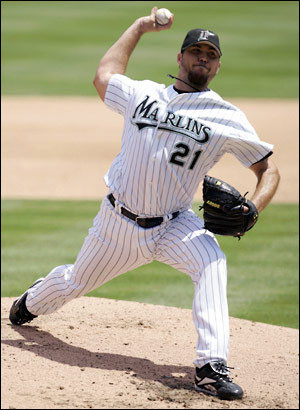 Florida Marlins pitcher Josh Beckett wearing the updated 2003 home uniform, characterized by black pinstripes and the "F" cap logo on the sleeve.
Florida Marlins pitcher Josh Beckett wearing the updated 2003 home uniform, characterized by black pinstripes and the "F" cap logo on the sleeve.
 Florida Marlins players Miguel Cabrera and Dontrelle Willis sporting the 2003 road gray uniforms, showcasing the updated "FLORIDA" script and black pinstripes.
Florida Marlins players Miguel Cabrera and Dontrelle Willis sporting the 2003 road gray uniforms, showcasing the updated "FLORIDA" script and black pinstripes.
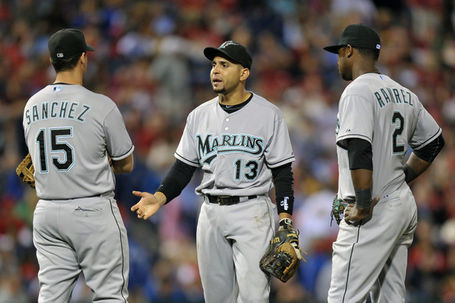 Hanley Ramirez and Omar Infante of the Florida Marlins in the black alternate jerseys introduced in 2003, featuring a silver "Marlins" script.
Hanley Ramirez and Omar Infante of the Florida Marlins in the black alternate jerseys introduced in 2003, featuring a silver "Marlins" script.
 A Florida Marlins player in the black alternate uniform, demonstrating the silver "Marlins" script and the overall design introduced in the 2003 season.
A Florida Marlins player in the black alternate uniform, demonstrating the silver "Marlins" script and the overall design introduced in the 2003 season.
The 2003 season proved to be another year of triumph for the Florida Marlins, as they once again defied expectations and won the World Series, defeating the New York Yankees. Despite ongoing payroll constraints, the team remained competitive throughout the Florida Marlins era, though further playoff appearances remained elusive. Over their 19-year run as the Florida Marlins, the team occasionally donned special uniforms to commemorate significant events and milestones.
In 1999, the Marlins participated in MLB’s “Turn Ahead the Clock” promotion, wearing futuristic short-sleeved black uniforms. These unique jerseys featured a large Marlins “F” cap logo tilted across the front. Complementing this look were special black caps with silver bills.
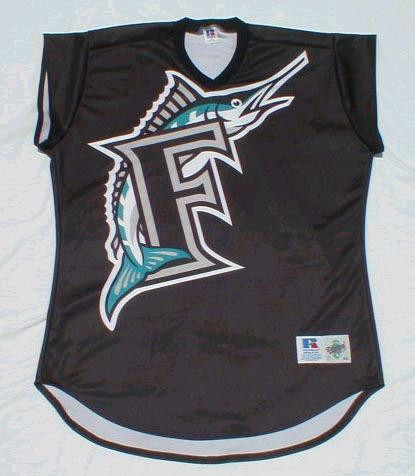 Florida Marlins "Turn Ahead the Clock" uniform from 1999, a futuristic design featuring short sleeves, black fabric, and a tilted "F-Marlin" logo.
Florida Marlins "Turn Ahead the Clock" uniform from 1999, a futuristic design featuring short sleeves, black fabric, and a tilted "F-Marlin" logo.
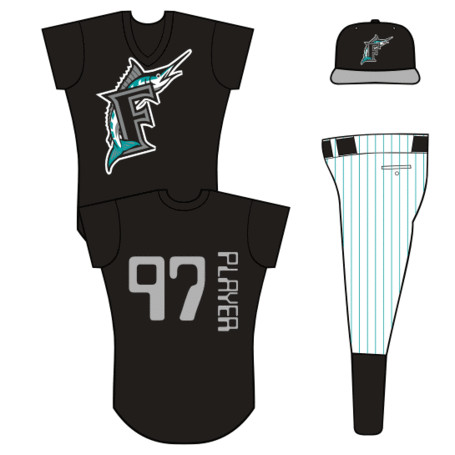 Close-up detail of the "Turn Ahead the Clock" Florida Marlins cap, showing the black base and silver bill, part of their special 1999 uniform set.
Close-up detail of the "Turn Ahead the Clock" Florida Marlins cap, showing the black base and silver bill, part of their special 1999 uniform set.
As previously mentioned, the team wore “Turn Back the Clock” uniforms in 2002 to honor the 1980s Miami Marlins minor league team.
 Florida Marlins players in "Turn Back the Clock" uniforms from 2002, recreating the look of the 1980s minor league Miami Marlins, in a game against the New York Mets.
Florida Marlins players in "Turn Back the Clock" uniforms from 2002, recreating the look of the 1980s minor league Miami Marlins, in a game against the New York Mets.
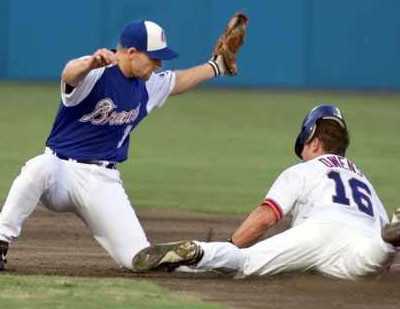 Another view of the 2002 throwback uniforms, worn against the Atlanta Braves, highlighting the block letter "MARLINS" script and classic color scheme.
Another view of the 2002 throwback uniforms, worn against the Atlanta Braves, highlighting the block letter "MARLINS" script and classic color scheme.
In 2003, the Marlins introduced a new home alternate uniform, which saw limited use over two seasons. This alternate was inspired by the iconic New York Yankees uniform style, replacing the famous “NY” logo with the Marlins cap logo.
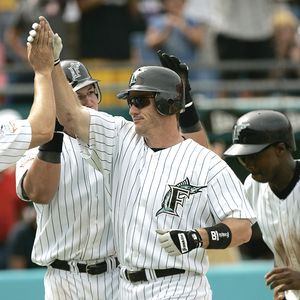 Florida Marlins player Mike Lowell in the Yankees-inspired alternate uniform from 2003, featuring the Marlins cap logo in place of the traditional "NY".
Florida Marlins player Mike Lowell in the Yankees-inspired alternate uniform from 2003, featuring the Marlins cap logo in place of the traditional "NY".
In 2007, the Marlins once again turned back the clock to commemorate the 110th anniversary of their 1997 World Series victory. They wore the sleeveless version of the uniforms they sported when they defeated the Cleveland Indians in that series, even staging the commemorative event against the Indians themselves.
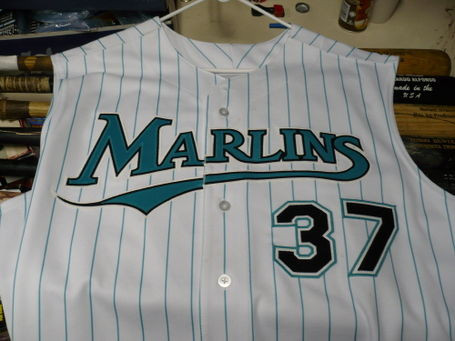 Florida Marlins players wearing sleeveless throwback uniforms from the 1997 World Series, during a 10th-anniversary celebration game against the Cleveland Indians in 2007.
Florida Marlins players wearing sleeveless throwback uniforms from the 1997 World Series, during a 10th-anniversary celebration game against the Cleveland Indians in 2007.
During the 2009 and 2010 seasons, the Marlins wore special “latino jerseys” for every Friday home game and a home series played in San Juan, Puerto Rico. These jerseys retained the team’s home designs but added “Los” script above the “Marlins” script, celebrating the team’s Latino fanbase and heritage.
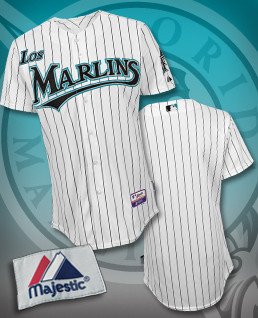 Florida Marlins "Los Marlins" Latino jersey, worn during the 2009 and 2010 seasons for Friday home games and series in Puerto Rico, featuring the "Los Marlins" script.
Florida Marlins "Los Marlins" Latino jersey, worn during the 2009 and 2010 seasons for Friday home games and series in Puerto Rico, featuring the "Los Marlins" script.
In 2012, the franchise embraced a new identity as the Miami Marlins, accompanied by sweeping changes. This rebranding included a renewed commitment to spending on player acquisitions and the inauguration of a new ballpark built on the former site of the Orange Bowl. For the Marlins, history had come full circle. Orange was reintroduced as a prominent color, in a vibrant red-orange shade, joining black, silver, blue, white, and yellow in the team’s new color scheme. The changes were visually striking, particularly in the bold use of colors and the introduction of a completely new set of logos. The Miami Marlins uniforms, while maintaining a traditional baseball uniform structure, were dramatically updated with the new colors and logos. Pinstripes were removed from the home uniform, and a new all red-orange cap was unveiled, marking a bold departure from previous designs.
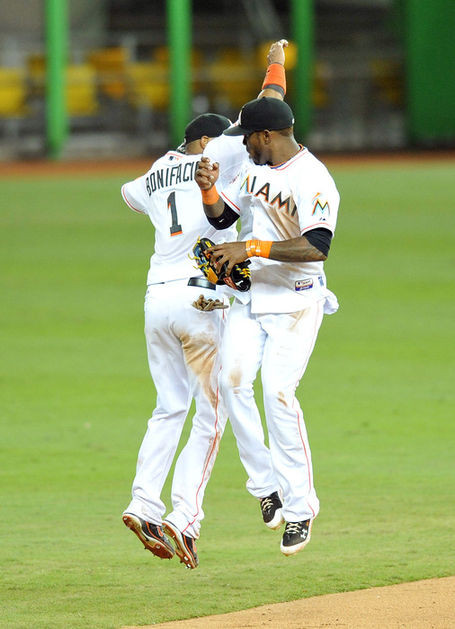 Miami Marlins player Giancarlo Stanton in the new 2012 home uniform, featuring a clean white design without pinstripes and the updated "Marlins" script.
Miami Marlins player Giancarlo Stanton in the new 2012 home uniform, featuring a clean white design without pinstripes and the updated "Marlins" script.
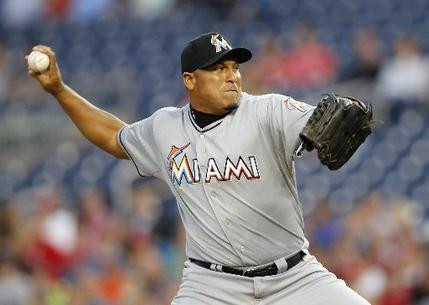 The Miami Marlins gray road uniform from 2012, showcasing the new color palette and modern "Miami" script, during a game against the Washington Nationals.
The Miami Marlins gray road uniform from 2012, showcasing the new color palette and modern "Miami" script, during a game against the Washington Nationals.
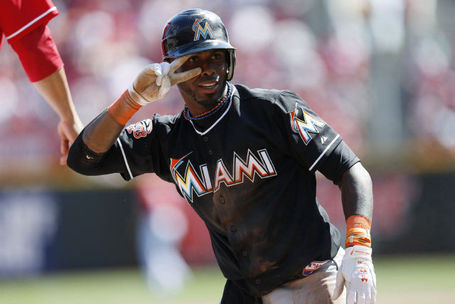 A close-up of the Miami Marlins new cap logo introduced in 2012, displaying the stylized "M" and Marlin design in vibrant new team colors.
A close-up of the Miami Marlins new cap logo introduced in 2012, displaying the stylized "M" and Marlin design in vibrant new team colors.
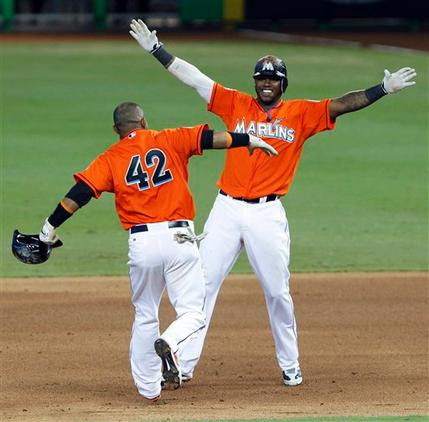 The Miami Marlins batting helmet from 2012, reflecting the team's new visual direction with its color scheme and logo integration.
The Miami Marlins batting helmet from 2012, reflecting the team's new visual direction with its color scheme and logo integration.
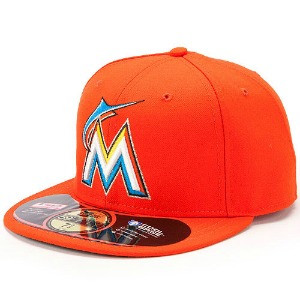 The striking red-orange cap of the Miami Marlins, a bold and distinctive element of their 2012 rebranding and new uniform set.
The striking red-orange cap of the Miami Marlins, a bold and distinctive element of their 2012 rebranding and new uniform set.
The Miami/Florida Marlins franchise has undergone numerous transformations in its visual identity over the years. While changes were often incremental, they became radical when the team transitioned into new eras. The minor league Marlins maintained a relatively consistent look, and the Florida Marlins era saw color scheme adjustments but largely preserved a similar overall style. The Miami Marlins rebranding introduced a look unlike any other team since the Houston Astros’ “rainbow guts” uniforms of the 1970s and 80s, pushing the boundaries of traditional baseball aesthetics. What does the future hold for the Marlins’ uniforms? Will they revisit the styles of the 1950s, 1980s, 1990s, or early 2000s for inspiration? One thing is certain: the Marlins have a history of challenging conventions and are likely to continue exploring the evolving visual landscape of Major League Baseball uniforms.
